Table of Contents
The most important thing I do every week is my Weekly Reset.
It’s my opportunity to pause, zoom out, and review what worked and didn’t work from the previous week, helping me to save thousands of hours of wasted effort.
And I want to help you do the same.
Living Intentionally
If, right now, you’re not where you want to be in life, it might be a sign you’re drifting instead of directing. Living your life on autopilot, rather than with intention.
I know how easily it happens — I’ve been there.
The crazy realisation I had is that most of us chase goals we inherit, not ones we consciously and carefully chose.
We follow paths laid out by school, parents, social media, and hustle culture, without ever questioning if those paths lead somewhere meaningful to us.
You get caught in the loop of doing, achieving, reacting. One day you realise you’ve been working hard, but not necessarily moving in the right direction. You’re ticking boxes, getting shit done, but never stopping to ask: Is this even what I want?
It’s what Rene Girard calls mimetic desire – the idea that we don’t just want things on our own. We want what others want. We model our desires based on what we see being validated or celebrated around us.
For example, you see someone crushing it with a startup, and suddenly you think maybe I should build one too. Or, you scroll past someone running an ultra, and suddenly that becomes your next big goal.
You don’t even realise it’s happening, but slowly your internal compass starts getting replaced by borrowed expectations.

“Man is the creature who does not know what to desire, and he turns to others in order to make up his mind. We desire what others desire because we imitate their desires” – René Girard
Left unchecked, this kind of desire pulls you off course. And the most concerning part is, you won’t notice until you’ve already arrived somewhere you never meant to go.
That’s why I’m a huge advocate for doing a Weekly Reset.
And if you’re interested in using the same template I use, here’s a link to download it for FREE:
So, let me show you what it involves.
The Weekly Reset
Every Sunday, I block out two hours for my Weekly Reset.
It doesn’t usually take that long. (Sometimes I’m done in half an hour). But the time is protected so I have the time and space to think without distraction and to avoid rushing into another week just reacting to whatever’s on my calendar.
Over hundreds of hours of doing this, I’ve refined it into a simple system I now use every week, built around four key elements that help me close the week with clarity and start the next one with intention:
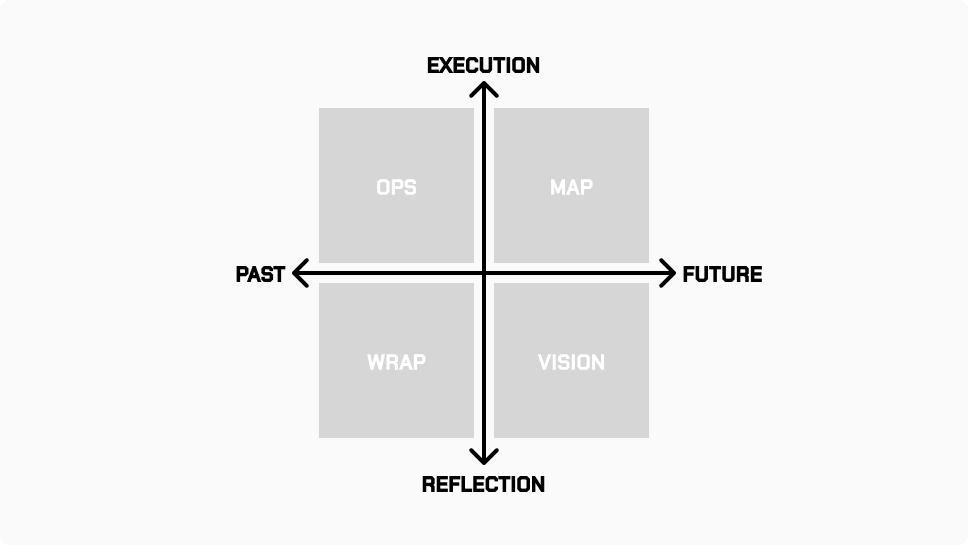
The idea is that each element (or quadrant, in the image above) represents a different lens to view your week through — so you’re not just thinking about what you did, but how you showed up, where you’re going, and what actually matters next.
I’m going to walk you through it now, but I think it’s important for me to mention that this isn’t a one-size-fits-all system. It’s just what works for me.
Your version might look different. Shorter. More flexible. Less structured. That’s fine. The goal isn’t perfection — it’s alignment and intentionality.
That being said, let’s take a look at what the Weekly Reset involves.
Personal Ops

The first part is what I call Personal Ops, because it’s about handling the essential maintenance tasks that keep your personal life running smoothly — like clearing your inboxes, tidying your space, organising your notes, and processing anything that’s built up over the week.
Just like a company has operations to keep everything functioning behind the scenes, Personal Ops is about doing the same for yourself.
Most people skip this step because it feels like a chore. But I’ve found that when my space is messy, my notes are scattered, my inbox is overflowing, my brain starts to carry that weight. And this brain fog leaks into everything else I’m trying to do.
So rather than dragging that friction into a new week, I clear it first.
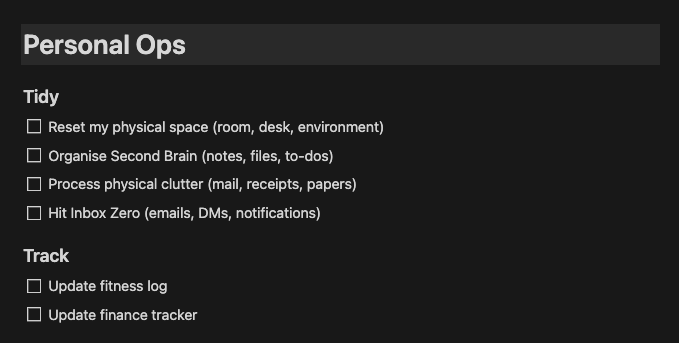
I break my Personal Ops into two parts:
- Tidying – this is about clearing mental, physical and digital space. It involves:
- Resetting my physical space by clearing my desk, putting things back in place, and making my environment look nice again.
- Organising my second brain, which mostly means cleaning up my digitial notes, as I’m always taking notes on stuff I find interesting in Apple Notes, and consolidating scattered tasks that need sorting.
- Processing physical clutter like receipts, unopened mail, and random bits of paper that’s build up over the week
- Hitting inbox zero across my emails, DMs, and other notifications. This mostly just means checking and responding to useful emails, then archiving the rest.
- Tracking – this is where I update a couple of key areas I care about monitoring more closely. For instance:
- My fitness log tracks how much I weigh, my performance in key exercises, and my general thoughts & feelings around my training progress
- My finance tracker tracks my income, expenses, and just where my money’s going more generally.
Once these two are done, I feel lighter. Clearer. Less cluttered in my head and ready to properly reflect on the previous week through the Weekly WRAP.
Weekly WRAP
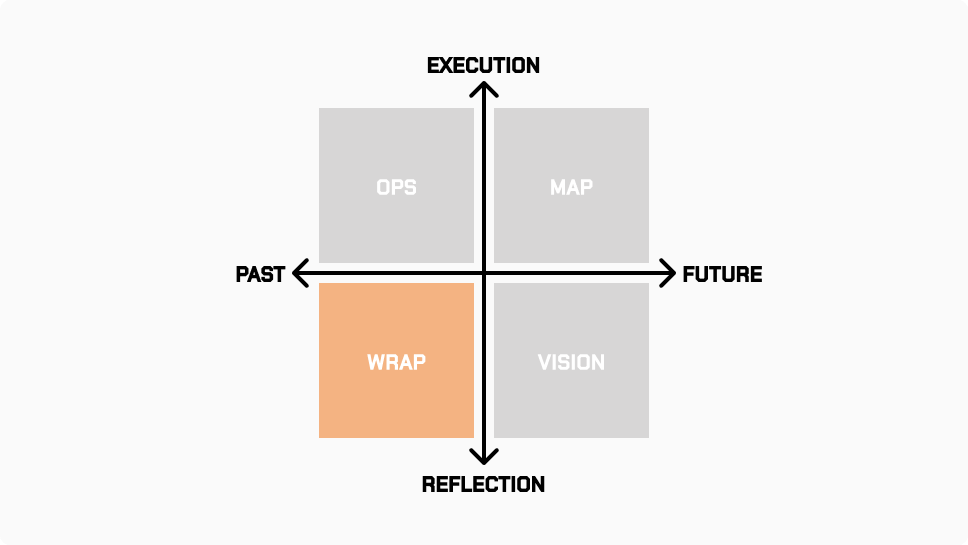
The Weekly WRAP is how I make sense of the week that just happened.
Not just in terms of what I did, but how I felt, how I showed up, and whether I moved in the right direction.
I used to find it way too easy to get to the end of a week having ticked off a bunch of tasks, and still have no idea whether any of it actually mattered and is bringing me closer to where I want to be. So, the WRAP framework helps me to avoid it.

Here’s how it breaks down:
- Wins – this is about surfacing the high points. The big or small moments that felt meaningful and brought momentum into my week. Too often we skip past our wins because we’re already focused on what’s next. But celebrating progress – even quietly – builds confidence and makes us feel a lot happier.
- For example, this week one of my wins was publishing my first newsletter in about 6 months. I also consider it a win that I found time every day to walk outside and enjoy the rare British sunshine.
- Results – this is my reality check. It’s where I hold up the mirror and ask: did I actually do the things I said I would? And I’m not on about the easy stuff, but the stuff that actually moved the needle. It’s so easy to feel productive because we’ve been being busy and replied to a few emails, so this section forces us to honestly assess what meaningful stuff got done.
- For example, I wanted to run 30 kilometres this week. Nothing too crazy, just a steady goal to support my hybrid training. And, I actually ran 37 kilometres, which is glorious.
- Alignment – this is where I zoom out and assess whether my actions and my results align with my personal values. I find doing this is important because without intentionally checking in, I can end up having a productive week and still feel off, which is usually a sign I’ve been operating out of sync with what actually matters to me.
- For example, I value doing things at a level I’m proud of and with as much care as possible. But this week I cut corners on a couple of things just to get them done faster, but it didn’t really feel that good. It didn’t feel me. So next week I’ll trade speed for quality.
- Pivot – finally, this is where I decide what needs to change for next week. Sometimes it’s obvious. Like this week, I realised I’d said yes to too many small things that didn’t move the needle. So the pivot would be to reduce inputs, protect deep work and say no more often. Other times it’s more subtle. But there’s always some small change we can make that can shift the entire trajectory of the week ahead.
Then, once I’ve done this, I close the loop on the past seven days and zoom out even further to connect to my personal vision.
Personal Vision

This is a relatively short part of the Weekly Reset, but without it I’ve found it’s easy to get lost in the noise of tasks, goals, and deadlines.
We spend so much time looking down — at to-do lists, calendar blocks, notificatons — that we rarely look up. And when we don’t look up, we forget where we’re going.
So, this part of the reset pulls me out of the week-to-week grind and asks: Am I still building the life I want?
And I’m mainly thinking about two things when I do this through my ‘future journaling’ exercise:
- First, am I becoming the kind of person I actually want to be?
- Second, am I working on what matters to me?
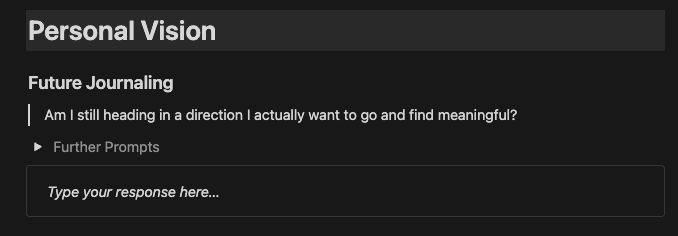
I also use this as an opportunity to reconnect with the long game by briefly reviewing my annual goals and 90-day goals I set at the start of the quarter.
Sometimes, goals expire. Priorities shift. What once lit me up might now feel heavy or forced.
And if I don’t stop to notice, I’ll keep pushing forward out of momentum or pride, instead of realigning with what matters now.
This is my moment to course-correct. To update the internal compass before I start sprinting again.
And once that’s clear — once I know who I’m becoming and what’s worth working toward — I can move with a lot more intention into the week ahead.
Weekly MAP
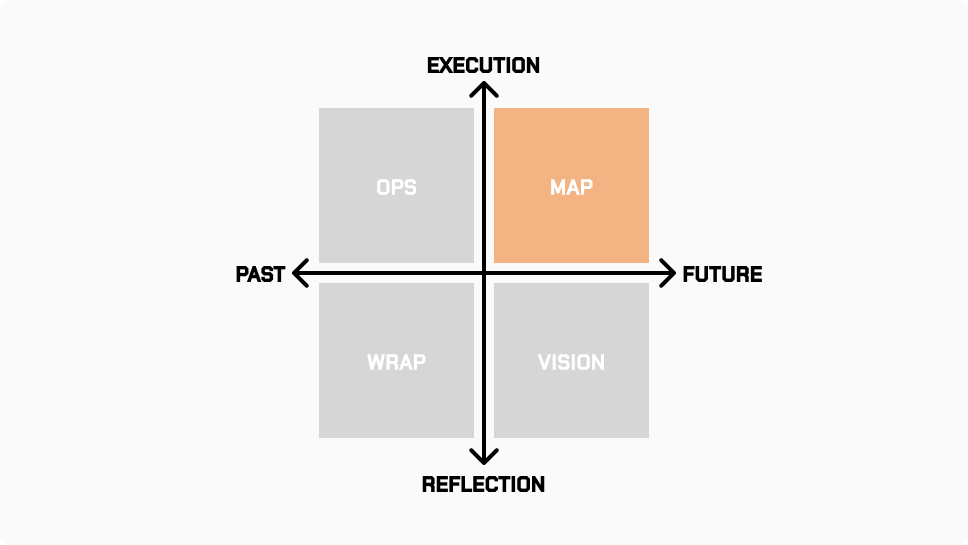
The Weekly MAP is the final thing I do, and it’s where I set out a clear, focused direction for the week ahead.
After clearing friction with Personal Ops, reflecting honestly through the WRAP, and reconnecting with the bigger picture in Personal Vision, this is where everything crystallises into action.
Because clarity without commitment is useless. You can journal all day long, but if it doesn’t translate into what you do, nothing changes.
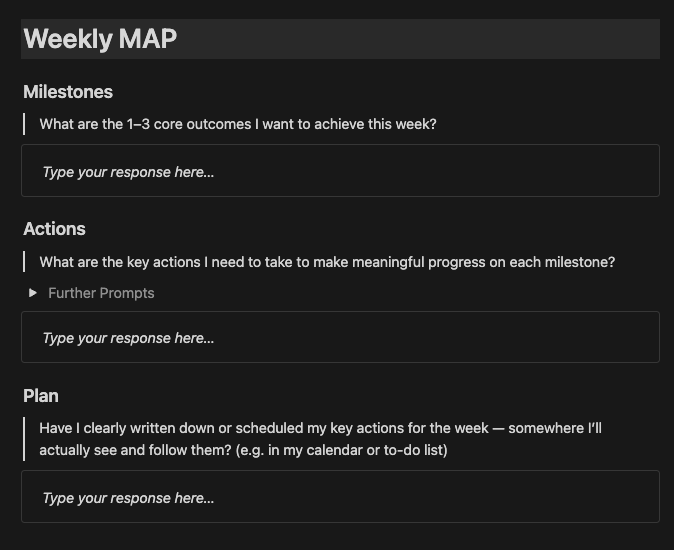
This section is broken down into three parts:
- Milestones – I choose 1-3 key outcomes I want to hit this week. Not a full to-do list. Just the core goals that would make me feel like the week was a win. They’re usually tied to a bigger project or long-term vision: a YouTube video I’m trying to ship, a training goal I’m building toward, or a business outcome I want to move forward.
- For example, this week my key outcomes are to publish a new video, finalise a plan for an exciting launch I’m doing this summer, and to run 40km.
- Actions – Once I’ve set my weekly milestones, I break them into clear actionable steps. The 3-5 most important things I need to make real progress. And one of the most useful tools I’ve come across for focusing on what really moves the needle is the ‘$10,000 Work Framework’ (see image below), where you categorise work based on leverage and impact, not just time or effort.
- $10 Work is reactive. You’re doing shallow, low-leverage tasks like answering emails, organising files, or clearing notifications. These things feel productive, but they rarely create momentum.
- $100 Work is tinkering. You’re researching, optimising, tweaking. Think: updating your Notion system, testing a new productivity app, or rewatching tutorials. It’s comfort work. You feel busy, but you’re mostly hiding.
- $1,000 Work is skilled execution. Writing, designing, creating, coaching, problem-solving — this work matters, but you’re still in a 1:1 time trade.
- $10,000 Work is high-skill, high-leverage that we want to spend most of our time doing. It’s the stuff that compounds over time. Building systems, creating assets, and making strategic decisions. It’s rare, it’s valuable, and it’s what builds long-term freedom.
- Plan – Finally, after locking in my actions, I make sure they’re visible so I actually do them. That might mean dropping them into a paper planner or time blocking them in a calendar. I’m still figuring out the thing that works best for me here, but at the moment I loosely put them into my calendar so I know what days to do things but never feel wedded to getting them done at a specific time as long as it’s done that week. But, regardless of what method you choose, I recommend to keep it simple.

And that’s it. That’s the weekly reset.
Again, if you want access to the template and all the questions I ask each week, here’s a link to access the Weekly Reset template it for FREE:
